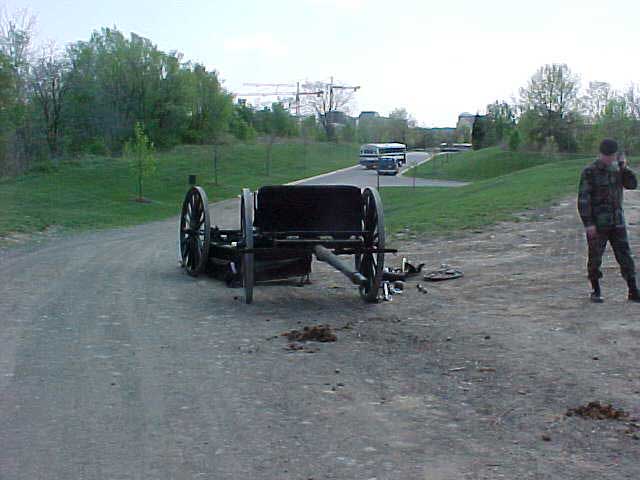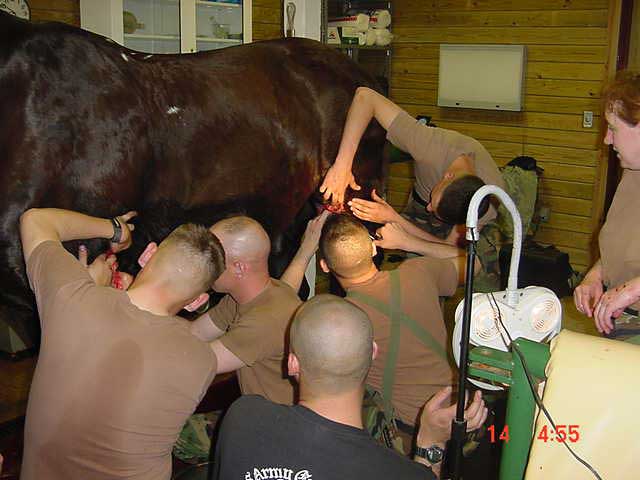Story by Sergeant Jamelle A. Colbert
Courtesy photos by the Caisson Platoon
Fort Myer, Virginia, April 18, 2002

Monday, soldiers of the 3d U.S.Infantry (The Old Guard) Caisson Platoon performed “above and beyond the call of duty,” or certainly beyond what their typically long and arduous days bring in the way of work.
The next day you want to complain of work on Monday, think of their day.
They stopped six 1,400-pound horses from flight, provided first aid to one of the panicked animals, built a training caisson to standard, re-hitched the new caisson, re-saddled horses and cleaned themselves up. And they reported 15 minutes early to render honors in their last funeral mission of the day.
The incident occurred at Arlington National Cemetery’s Patton Circle area, around 1:30 p.m. during a lull in the soldiers’ day when they normally stop to drink water and relax.
“We are still trying to determine what made them run,” Chief Warrant Officer Charles Sowles said, noting however that it was the lead pair that took off. Sowles, the platoon leader for the Caisson unit said “it could have been a number of things, but a horse’s first reaction when they are afraid is generally to flee.
“Something as simple as a bee sting or the extreme heat could have prompted the two front horses to run. If one horse gets a little excited, it’s normally a chain reaction. The way horses think is, if one horse has something to be afraid of, then they all do,” said Sowles.
“Once they get going there’s not much a soldier, who typically weighs 180 pounds, can do to stop them,” said Sowles. Although no soldiers were injured during the incident, the rear wheel horse, Lee, fell and sustained injuries to his hind and front legs as well as scratches to his stomach.
The damage to the caisson itself is considered fairly superficial, according to the platoon leader. It is believed that Lee and his harness-mate, Grant, were actually trying to dig in, as wheel horses do, to stop the other horses and the caisson a when Lee fell down and was pulled a few yards by the other horses.
Pfc. Colin Kingsbury, a wheel rider for the caisson platoon was on the mission with the downed caisson that day. “I was a little scared at first. I didn’t immediately realize what was going on, but as soon as I did, I tried to grab the lead horses’ reins. We started sprinting after them, trying to stop them,” Kingsbury said.
“When Lee went down I was really scared because his injuries looked bad. I kept thinking of what to do next,” Kingsbury continued.
“We removed Lee’s tack, calmed and controlled him as well as the other horses. Everyone kept their cool and did what we had to do,” said Kingsbury.
Doing what they had to do also included rendering first aid for Lee, now bleeding heavily from the wounds to his legs. “We used the blankets to apply pressure and control the bleeding, just as we were taught in basic training,” Kingsbury said.
The medical care shifted to the platoon’s assigned veterinarian technician, Staff Sgt. Ward Lacy, who arrived with other help on getting word of the trouble.
The caisson team, knowing they were “in a bind” for time, left Lee and the damaged caisson in the care of others to return to the stables with the five other horses, unhitched, and the section sergeant’s horse.
A hundred percent accountability was done of the horses, their equipment, the caisson and the soldiers. Meanwhile another group of soldiers gathered and began taking parts from the damaged caisson to fit out the training caisson, a piece of equipment purchased two years ago at Fort Sill, Oklahoma.
Using two new wheel horses and replacements for Lee and Grant at the wheel positions, the caisson team refitted within an hour and 10 minutes — 15 minutes ahead of time for their 3 p.m. mission.
The soldiers’ of the Caisson Platoon can handle up to eight funerals using both of their two working caissons. The platoon has 33 horses, 27 of which are on working status, and 46 enlisted soldiers. On Monday each of the two regularly used caissons were hitched up and in the cemetery performing four funerals apiece.
“These caissons were built in 1918,” said Sowles, With 1,500 funerals a year, each caisson gets about 700 missions. Occasionally they need to be reconditioned. Rebuilding the damaged caisson will cost an estimated $2,000.
Under the direction and guidance of Capt. Janice Baker, the Fort Myer Military Community veterinarian, several soldiers remained on duty late into the night cleaning out the wounds and applying sutures and bandages to the injured horse. Lee has been on duty at the Caisson stables since March 1996.
Sgt. 1st Class Ronald Poston said Lee, on duty with the Old Guard since March 1996, is a resilient horse.
“He is one of the biggest, toughest and strongest horses in the barn,” Sowles said. “We give him eight weeks of recovery time before we think he’ll be ready to return to duty.”
Lee is a stablemate as well as harnessmate for Grant, a horse with vision in one eye. With Lee in the treatment facility, with slings to relieve pressure on his injured legs, Grant has been moved in alongside, keeping both horses calm.
Poston had nothing but praise for the way the soldiers reacted to the emergency. “It really shows the amount of training and professionalism the soldiers down here have,” First they found out of any of the soldiers were hurt, second if the horses were okay. “Most important for us is mission accomplishment,” he said. Although “this happened right in the middle of the duty day, these soldiers pulled it out so that no honors were dropped whatsoever for anyone being respected that day.” said Poston.
“The only people who make sure that happens are the soldiers who work down here.”
(Colbert is public affairs NCOIC for the 3rd U.S. Infantry.)
Michael Robert Patterson was born in Arlington and is the son of a former officer of the US Army. So it was no wonder that sooner or later his interests drew him to American history and especially to American military history. Many of his articles can be found on renowned portals like the New York Times, Washingtonpost or Wikipedia.
Reviewed by: Michael Howard

